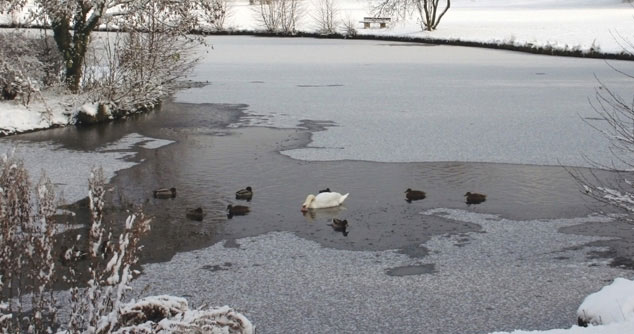Lake and Pond Management
Ponds and lakes are a valuable natural resource. They add beauty to the landscape, provide recreation, and are a habitat for fish and wildlife. A natural body of water is a complex biological, chemical, and physical community. The quality of the water determines the health of the entire ecosystem and the aquatic organisms living within it – from microscopic bacteria to large fish.
The “engine” that drives everything within a body of water is the presence of oxygen in proper levels. A pond’s condition deteriorates when its bottom environment cannot support aquatic life. The bottom is where the most oxygen is consumed and the farthest from the surface where it is replenished. Without adequate oxygen at the bottom, beneficial bacteria do not break down the organic waste. This results in increased layers of sediment (muck) along the pond bottom. Simply put: without oxygen, a pond cannot clean itself. Years of experience has taught us that three main tools are needed to manage ponds and lakes:
Aeration. Bubbling fountains and diffused air systems are commonly used to increase the natural levels of oxygen. The added oxygen and, equally important, the circulation created by these devices help to create a stable and productive ecosystem. Fountains typically float on the surface and spray water up into the air. As the water droplets fall back to the surface, they pick up oxygen. Fountains also create surface ripples and circulation, which help to keep the surface clean. Diffused air systems utilize a shore-mounted air compressor that pumps oxygen through a hose to a special diffuser lying on the pond bottom. Since the bottom of the pond is where the most oxygen is consumed, it is an ideal way to deliver oxygen to where it’s needed most. As the bubbles rise out of the diffusers, they create a “lifting” or boiling action, which creates considerable circulation throughout the pond. This circulation helps to prevent water stratification.
Beneficial Bacteria. For over two decades, we have been using bacteria to help Mother Nature keep waters clean and clear. Back then, very few companies were using this approach, and we got quite a few funny looks when we told people to add “bacteria” to the water. Today, thousands of happy customers later, the use of natural bacteria to help reduce sludge build-up and increase water quality is widely used and embraced. By adding billions of these naturally occurring organisms, you can reverse the aging process of ponds that occurs when fish waste, leaves, dead weeds/algae, runoff, etc. start to build up on the bottom. The results are improved water quality, reduced odors, improved oxygen levels, and a better environment for fish and other aquatic life.
Weed and Algae Controls. There are a wide variety of treatment products available to safely control aquatic weeds and algae in ponds and lakes. These tested and approved products are a safe and quick way to gain control of waters that are infested with aquatic weeds or algae. The use of these products is a good short-term solution to a problem; however, to gain more long-term control, you should look at the overall ecosystem and determine what the real cause of the problem is. Often aeration and/or the use of bacteria will greatly improve the system and the use of these chemicals can be reduced.

